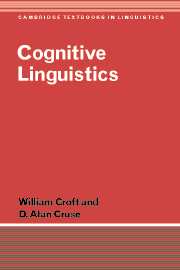Book contents
- Frontmatter
- Contents
- Figures
- Tables
- Preface
- 1 Introduction: what is cognitive linguistics?
- A conceptual approach to linguistic analysis
- Cognitive approaches to lexical semantics
- Cognitive approaches to grammatical form
- 9 From idioms to construction grammar
- 10 An overview of construction grammars
- 11 The usage-based model
- 12 Conclusion: cognitive linguistics and beyond
- References
- Index
- Index
11 - The usage-based model
Published online by Cambridge University Press: 05 June 2012
- Frontmatter
- Contents
- Figures
- Tables
- Preface
- 1 Introduction: what is cognitive linguistics?
- A conceptual approach to linguistic analysis
- Cognitive approaches to lexical semantics
- Cognitive approaches to grammatical form
- 9 From idioms to construction grammar
- 10 An overview of construction grammars
- 11 The usage-based model
- 12 Conclusion: cognitive linguistics and beyond
- References
- Index
- Index
Summary
Grammatical representation and process
Grammatical knowledge is not merely a representational structure in the mind of a speaker. In a recent survey of knowledge representation models in psychology, Markman argues that there are four basic elements to a model of knowledge representation (1999:5–10). One element is the representing world, that is, the domain of the representations themselves. In the cognitive linguistic approach to language, the representing world is of course the mind. A second element is the represented world. For grammatical knowledge, the represented world is utterances, that is, the form of utterances and their meaning in the discourse context. The third and fourth elements in Markman's analysis are some mechanism to link the representing world to the represented world, and processes using the representation. This last element is particularly important:
It makes no sense to talk about representations in the absence of processes … Only when there is also a process that uses the representation does the system actually represent, and the capabilities of a system are defined only when there is both a representation and a process.
(Markman 1999:8)The primary processes in which grammatical knowledge is involved are communication – the production and comprehension of utterances; the acquisition of grammatical knowledge by children and by adults; and the changes in grammatical knowledge of speakers over time. These processes link the representing world – the grammatical knowledge – and the represented world – the world of utterances and their meanings.
- Type
- Chapter
- Information
- Cognitive Linguistics , pp. 291 - 327Publisher: Cambridge University PressPrint publication year: 2004



